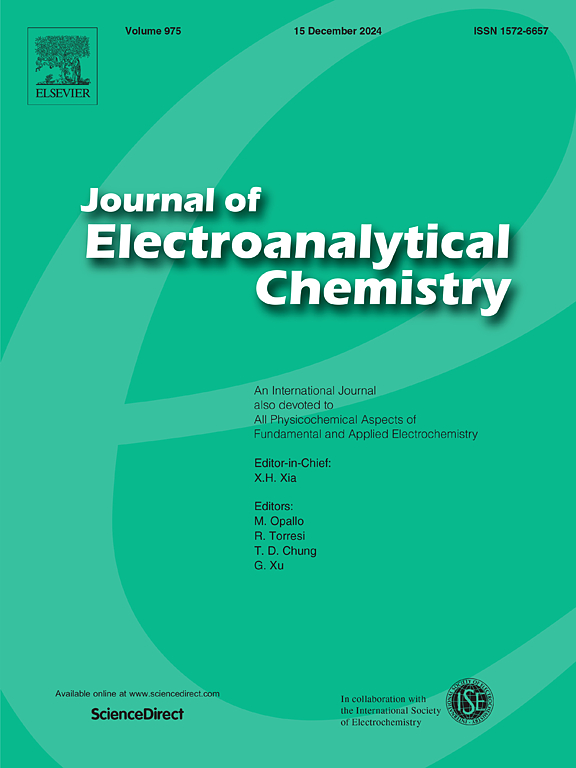用于储能的三元吡啶金属结构(Zn, Cu, Fe):电化学分析和理论建模
IF 4.1
3区 化学
Q1 CHEMISTRY, ANALYTICAL
引用次数: 0
摘要
以三吡啶为配体的金属配合物(C1-C6)的设计和研究因其在储能技术中具有广阔的应用前景而备受关注。在这项研究中,我们报道了锌(II)、铜(II)和铁(II)配合物结合三联吡啶基支架的电化学行为。本研究独特地引入烷基和烷氧基取代的三吡啶金属配合物用于电化学储能,表明这些结构修饰有效地优化了氧化还原活性并促进了电荷传输特性的改善。使用循环伏安法评估了它们的电化学行为,揭示了明显的氧化还原特性和良好的可逆性,特别是在Cu(II)体系中,这强调了其作为氧化还原活性中心在能源相关应用中的潜力。利用互补密度泛函理论(DFT)计算阐明了其电子结构、前沿分子轨道和电荷分布,并对其氧化还原特性和稳定性提供了详细的见解。实验结果与计算结果的相关性突出了金属中心对三吡啶核电子调制的影响。综合电化学和理论分析表明,这些配合物作为下一代储能系统的功能材料具有相当大的前景。本文章由计算机程序翻译,如有差异,请以英文原文为准。
Terpyridine–metal architectures (Zn, Cu, Fe) for energy storage: electrochemical analysis and theoretical modeling
The design and investigation of metal complexes (C1-C6) featuring terpyridine ligands have gained significant attention due to their promising roles in energy storage technologies. In this study, we report the electrochemical behavior of Zn(II), Cu(II), and Fe(II) complexes incorporating terpyridine-based scaffolds. This study uniquely introduces alkyl- and alkoxy-substituted terpyridine metal complexes for application in electrochemical energy storage, demonstrating that these structural modifications effectively optimize redox activity and facilitate improved charge transport characteristics. Their electrochemical behavior was evaluated using cyclic voltammetry, revealing distinct redox characteristics and favorable reversibility profiles, particularly in the Cu(II) system, which underscores its potential as a redox-active center in energy-related applications. Complementary density functional theory (DFT) calculations were performed to elucidate the electronic structures, frontier molecular orbitals, and charge distribution, offering detailed insights into their redox properties and stability. Correlation between experimental findings and computational results highlights the influence of the metal center on the electronic modulation of the terpyridine core. The integrated electrochemical and theoretical analyses suggest that these complexes hold considerable promising nature as functional materials in next-generation energy storage systems.
求助全文
通过发布文献求助,成功后即可免费获取论文全文。
去求助
来源期刊
CiteScore
7.80
自引率
6.70%
发文量
912
审稿时长
2.4 months
期刊介绍:
The Journal of Electroanalytical Chemistry is the foremost international journal devoted to the interdisciplinary subject of electrochemistry in all its aspects, theoretical as well as applied.
Electrochemistry is a wide ranging area that is in a state of continuous evolution. Rather than compiling a long list of topics covered by the Journal, the editors would like to draw particular attention to the key issues of novelty, topicality and quality. Papers should present new and interesting electrochemical science in a way that is accessible to the reader. The presentation and discussion should be at a level that is consistent with the international status of the Journal. Reports describing the application of well-established techniques to problems that are essentially technical will not be accepted. Similarly, papers that report observations but fail to provide adequate interpretation will be rejected by the Editors. Papers dealing with technical electrochemistry should be submitted to other specialist journals unless the authors can show that their work provides substantially new insights into electrochemical processes.

 求助内容:
求助内容: 应助结果提醒方式:
应助结果提醒方式:


